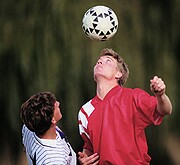- Skip Storing This Everyday Product in the Fridge Door
- Green Tea + B3 Pairing May Boost Brain Health
- Navigating Your Midlife Crisis: Embracing New Possibilities
- City Raccoons Showing Signs of Domestication
- Mapping the Exposome: Science Broadens Focus to Environmental Disease Triggers
- One Week Less on Social Media Linked to Better Mental Health
- Your Brain Changes in Stages as You Age, Study Finds
- Some Suicide Victims Show No Typical Warning Signs, Study Finds
- ByHeart Formula Faces Lawsuits After Babies Sickened With Botulism
- Switch to Vegan Diet Could Cut Your Greenhouse Gas Emissions in Half
Expert Tips for Preventing Kids’ Sports Injuries


“Put me in, Coach,” may be a common plea heard from young athletes. But sports medicine experts suggest that benching players for at least part of the year might help prevent sports-related injuries.
“The biggest problem right now is that many children and teens are not taking time off from their sports activities,” said Dr. James Penna, an orthopedic surgeon at Stony Brook University Hospital in Stony Brook, N.Y.
“Young athletes need to rest, but many participate in sports year-round, which can result in overuse injuries,” he said in a hospital news release.
To prevent overuse injuries such as stress and growth plate fractures, Penna recommends taking a two- to four-month break from any one sport, “especially the sports that involve overhand motion such as tennis and baseball,” he said.
Children who participate in year-round sports such as gymnastics and swimming should be taught to warm up and stretch properly. For these athletes, scheduling rest time and changing exercise patterns can help prevent injuries. Making sure children use proper techniques and have good form is also important, Penna said.
Appropriate safety gear, such as helmets and pads, are also essential.
“Most major organized sports — football, baseball, hockey, lacrosse — have done a good job of ensuring that children wear appropriate protective head gear, which helps prevent head injuries and concussions,” Penna said.
Helmets, pads and other safety equipment are also important for children involved in skateboarding, BMX biking, skiing and snowboarding since they are at higher risk for serious injuries, he explained.
“If a head injury has occurred, it is particularly important that the child gets 100 percent clearance from his or her doctor, including a complete neurologic checkup, before playing again,” Penna said.
“A seemingly minor head injury sustained while a child is still symptomatic from a prior injury could have catastrophic consequences,” he cautioned.
And parents should know that football isn’t the only team sport where kids can get a concussion. “Currently, the concussion rates are higher among soccer players than among football players, and we’ve found that soccer head injuries have tended to go undertreated,” Penna said.
Another way parents can prevent sports-related injuries among their kids is to pay attention to their shoes and look for signs of wear.
In general, a pair of cleats lasts one season, but it’s still important to check the shoes’ insoles and spikes periodically to make sure they are in good condition. This can help avoid foot and ankle injuries.
Children who play organized sports should also drink plenty of water to stay hydrated, Penna added.
More information
The American Academy of Pediatrics provides more information on how to prevent sports injuries.
Source: HealthDay
Copyright © 2025 HealthDay. All rights reserved.










